
Dessert is a course that concludes a meal. The course consists of sweet foods, such as cake, biscuit, ice cream and possibly a beverage such as dessert wine and liqueur. Some cultures sweeten foods that are more commonly savory to create desserts. In some parts of the world there is no tradition of a dessert course to conclude a meal.

A doughnut or donut is a type of pastry made from leavened fried dough. It is popular in many countries and is prepared in various forms as a sweet snack that can be homemade or purchased in bakeries, supermarkets, food stalls, and franchised specialty vendors. Doughnut is the traditional spelling, while donut is the simplified version; the terms are used interchangeably.

Gulab jamun is a sweet confectionary or dessert, originating in the Indian subcontinent, and a type of mithai popular in India, Pakistan, Nepal, the Maldives and Bangladesh, as well as Myanmar. It is also common in nations with substantial populations of people with South Asian heritage, such as Mauritius, Fiji, Gulf states, the Malay Peninsula, United Kingdom, United States, Canada, South Africa, and the Caribbean countries of Jamaica, Trinidad and Tobago, Guyana, and Suriname.
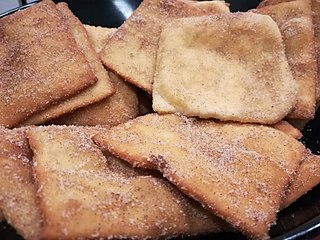
A sopaipilla, sopapilla, sopaipa, or cachanga is a kind of fried pastry and a type of quick bread served in several regions with Spanish heritage in the Americas. The word sopaipilla is the diminutive of sopaipa, a word that entered Spanish from the Mozarabic language of Al-Andalus. The original Mozarabic word Xopaipa was used to mean bread soaked in oil. The word is derived in turn from the Germanic word suppa, which meant bread soaked in liquid.

Kuih are bite-sized snack or dessert foods commonly found in Southeast Asia and China. It is a fairly broad term which may include items that would be called cakes, cookies, dumplings, pudding, biscuits, or pastries in English and are usually made from rice or glutinous rice. In China, where the term originates from, kueh or koé (粿) in the Min Nan languages refers to snacks which are typically made from rice but can occasionally be made from other grains such as wheat. The term kuih is widely used in Malaysia, Brunei, and Singapore, kueh is used in Singapore and Indonesia, kue is used in Indonesia only, all three refer to sweet or savoury desserts.

Khaja is an Indian deep-fried pastry, commonly filled with fruit or soaked with sugar syrup.

Puran poli is an Indian sweet flatbread that is popular in South India and the state of Maharashtra. It is also known as puran puri, holige, obbattu, bobbatlu, poley, bakshamulu, and boli.
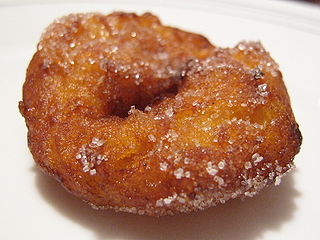
A buñuelo (Spanish:[buˈɲwelo], alternatively called boñuelo, bimuelo, birmuelo, bermuelo, bumuelo, burmuelo, or bonuelo, is a fried dough fritter found in Spain, Latin America, and other regions with a historical connection to Spaniards, including Southwest Europe, the Balkans, Anatolia, and other parts of Asia and North Africa. Buñuelos are traditionally prepared at Christmas. It will usually have a filling or a topping. In Mexican cuisine, it is often served with a syrup made with piloncillo.
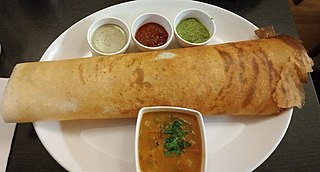
Indian breads are a wide variety of flatbreads and crêpes which are an integral part of Indian cuisine. Their variation reflects the diversity of Indian culture and food habits.

Kue is an Indonesian bite-sized snack or dessert food. Kue is a fairly broad term in Indonesian to describe a wide variety of snacks including cakes, cookies, fritters, pies, scones, and patisserie. Kue are made from a variety of ingredients in various forms; some are steamed, fried or baked. They are popular snacks in Indonesia, which has the largest variety of kue. Because of the countries' historical colonial ties, Koeé (kue) is also popular in the Netherlands.
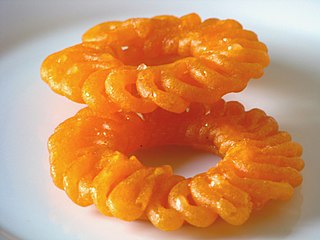
Imarti is a sweet from India. It is made by deep-frying vigna mungo flour batter in a circular flower shape, then soaking in sugar syrup. Alternative names include Amitti, Amriti, Emarti, Omritti, Jahangir and Jhangiri/Jaangiri. This dish is not to be confused with jalebi, which is thinner and sweeter than Imarti.

Ariselu or Arisa is an Indian sweet from Andhra Pradesh, Odisha, Telangana. It is also called Kajjaya in Kannada, Adhirasam in Tamil Nadu, Neyyappam in Kerala ,Anarsa in Marathi, arsa or anarsa in Uttarakhand, Bihar and Jharkhand.

Gujhia, also known as Gughara, Pedakiya, Purukiya, Karanji, Kajjikayalu, Somas, and Karjikayi, is a sweet, deep-fried pastry that is a popular dessert in the Indian subcontinent. This delicacy is made using either suji (semolina) or maida, which is stuffed with a mixture of sweetened khoa and dried fruits. The dumpling is then fried in ghee to give it a crispy texture.

Sweet shells is one of the typical Indian sweets made in Andhra Pradesh, India. It is a mixture (dough) of plain flour/maida and water or milk. The prepared dough is shaped into small rounds, which are flattened and rolled so as to take the shape of gavvalu. These shells are fried in oil or ghee and soaked in sugar or jaggery syrup.
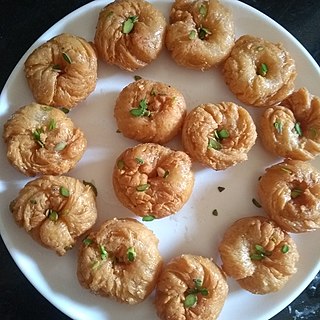
Makhan Bada is a traditional dessert originating from the Indian subcontinent. It is also known as Balusaahi and is similar to a glazed doughnut in terms of Ingredients, but differs in texture and taste. Makhan Bada also resembles Rajasthani Baati in terms of size & preparation but resembles more with Medu Vada in terms of shape. In South India, a similar pastry is known as badusha.
Tapeswaram is a village in Mandapeta mandal of Konaseema district, Andhra Pradesh. The Uma Agastheswara Temple in Tapeswaram has a great importance and is believed to be constructed by Agasthya.

Andhra cuisine, culturally known as Telugu cuisine, is a cuisine of India native to the state of Andhra Pradesh and is the culinary style of Telugu people. It is generally known for its tangy, hot, and spicy taste.
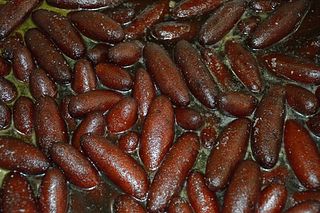
Lyangcha, Langcha, or Lemcha, is an Indian sweet dish prepared in West Bengal, Jharkhand, Odisha, Bihar, Assam, Tripura and also throughout Bangladesh. It is made from flour and milk powder by frying it and dipping it into sugar syrup for a long time. The origin of the sweet is in Bardhaman, West Bengal, India. The Government of West Bengal has begun the process of registering Geographical indication (GI) for Lyangcha.

















